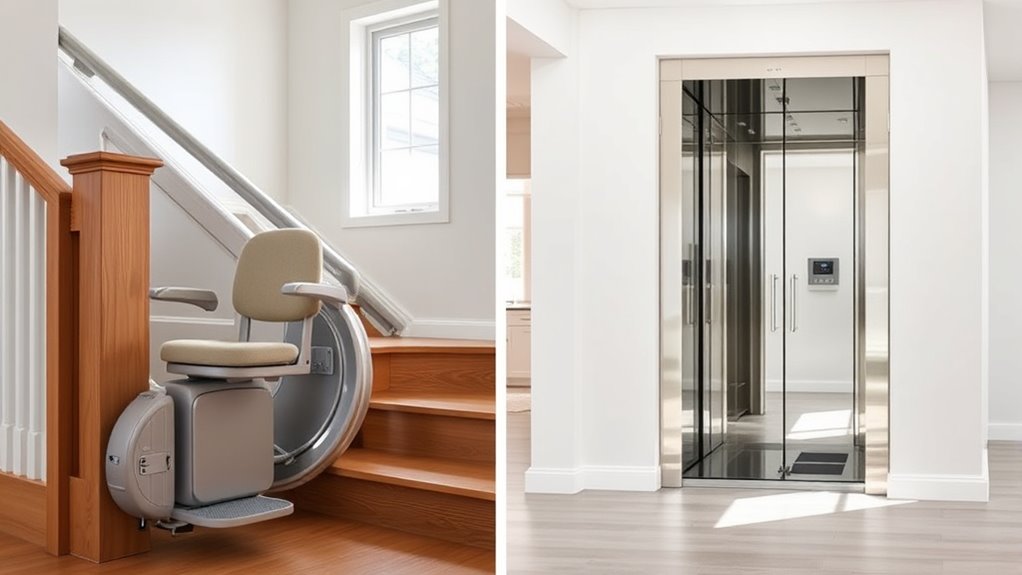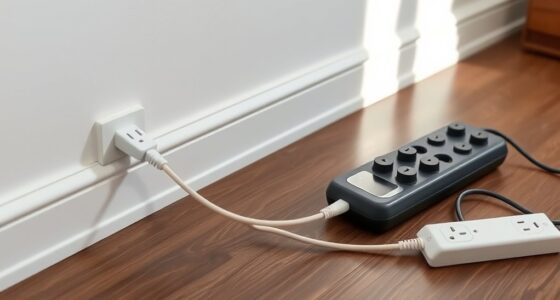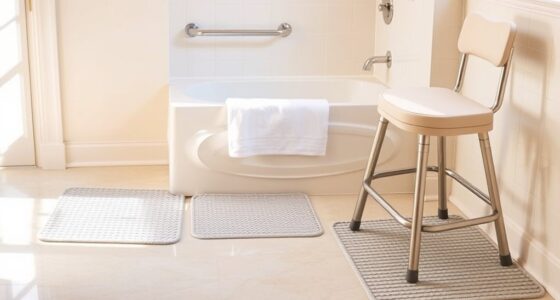Stair lifts are a quick, cost-effective way to move safely between floors, fitting easily along existing staircases without major home modifications. In contrast, home elevators offer more space, can accommodate wheelchairs, and serve multiple levels, but they come with higher costs and longer installation times. Your choice depends on your mobility needs, home layout, and budget. For a clearer picture of which option suits you best, discover more details below.
Key Takeaways
- Stair lifts are cost-effective, typically $3,000-$5,000, while home elevators start around $15,000 and can exceed $30,000.
- Stair lifts are quicker and easier to install, often within a day, with minimal home modifications compared to the extensive work required for elevators.
- Elevators provide spacious, multi-floor access suitable for wheelchairs and large mobility devices, whereas stair lifts are designed for seated rides on individual staircases.
- Stair lifts are ideal for single staircases and limited mobility needs, while elevators serve multi-story homes with broader accessibility requirements.
- Both options enhance safety and home value, but elevators offer greater independence and accessibility for individuals with significant mobility challenges.

When choosing between stair lifts and home elevators, understanding their differences can help you make the best decision for your needs. One of the key factors to consider is accessibility options. Stair lifts are designed to be simple and straightforward, providing a seated ride up and down your existing staircase. They are ideal if you want a quick, cost-effective solution that requires minimal changes to your home. Most models can be customized to fit different staircases, whether straight or curved, and they often come with features like adjustable seats, armrests, and safety belts. Home elevators, on the other hand, offer a more extensive accessibility solution. They are capable of transporting individuals in wheelchairs or with mobility devices, providing a spacious interior with wide doors and smooth, level floors. Elevators can be designed to serve multiple floors, giving you greater independence and convenience in multi-story homes.
Stair lifts are simple, cost-effective, and customizable; home elevators offer spacious, multi-floor accessibility solutions.
Installation considerations are another essential aspect. Stair lifts are generally easier and faster to install. The process usually involves mounting a track along your staircase and attaching the lift to it, which can often be completed within a day or two. Because they don’t require structural modifications, installing a stair lift is less invasive and less costly. Home elevators require more extensive planning and structural adjustments. Installing an elevator involves creating a shaft or hoistway, reinforcing floors, and often upgrading electrical systems to support the new equipment. This process can take several weeks and is more disruptive, especially in homes that need significant modifications. The choice depends on your budget, timeline, and how much disruption you’re willing to endure.
Cost is another differentiator. Stair lifts tend to be more affordable upfront, with prices generally ranging from around $3,000 to $5,000, including installation. They provide a practical solution for many homeowners without breaking the bank. Home elevators, however, come with a higher price tag, often starting at $15,000 and climbing well beyond $30,000 depending on features and customization. Despite the higher cost, elevators can add value to your home and cater to a broader range of mobility needs.
Ultimately, your decision hinges on your personal mobility requirements, home layout, and financial considerations. If you need a quick, budget-friendly option primarily for one staircase, a stair lift might be the best fit. But if you’re seeking a more versatile, accessible solution that can serve multiple floors and accommodate wheelchairs, a home elevator could be worth the investment. Both options improve safety and independence, so weighing their accessibility options and installation considerations will help you choose the right solution for your lifestyle.
Frequently Asked Questions
What Are the Maintenance Requirements for Stair Lifts and Home Elevators?
You should follow regular maintenance routines to guarantee your stair lift or home elevator stays reliable and lasts longer. For stair lifts, clean rails and check batteries periodically. Home elevators require professional inspections, door alignment checks, and lubrication of moving parts. Proper maintenance helps prevent breakdowns, extends system longevity, and keeps safety features functioning correctly. Staying on top of these routines means you’ll enjoy smoother operation and peace of mind for years to come.
How Do Installation Times Compare Between Stair Lifts and Home Elevators?
Installation duration for stair lifts is quick, often completed within a few hours, fitting into your existing staircase without major construction. In contrast, home elevators require a longer construction timeline, sometimes taking several days or weeks, as they involve structural modifications and electrical work. You’ll find stair lifts are a convenient choice if you need a swift solution, whereas home elevators suit those planning a more extensive, permanent upgrade.
Are There Weight or Size Limitations for Each Option?
Back to the future, you’ll find weight restrictions and size constraints differ for each option. Stair lifts typically support up to 350-400 pounds, while home elevators often handle more, around 500-1,000 pounds. Size limits vary based on model, but elevators usually accommodate larger wheelchairs and multiple passengers. Always verify the specific weight restrictions and size constraints for your chosen system to guarantee safety and comfort.
What Are the Safety Features Common to Both Stair Lifts and Elevators?
Both stair lifts and home elevators include safety features like safety sensors that detect obstacles and stop the device to prevent accidents. Emergency stops are also standard, allowing you to quickly halt the lift or elevator if needed. These features guarantee your safety during operation, giving you peace of mind. Always check that these safety features are properly installed and regularly maintained for maximum protection.
Can These Systems Be Customized for Unique Home Layouts?
Think of these systems as blank canvases—yes, they can be customized to fit your home like a glove. With design flexibility and space optimization in mind, manufacturers tailor stair lifts and elevators to match your unique layout. Whether it’s a tight corner or a spacious hall, these solutions adapt seamlessly, ensuring safety and style blend harmoniously with your home’s architecture.
Conclusion
Choosing between a stair lift and a home elevator is like picking between a trusty bicycle and a majestic elevator—each takes you to new heights, but in different ways. Think of a stair lift as your reliable companion that hugs the stairs, while a home elevator is your private elevator shaft to luxury. Consider your needs, space, and dreams, and you’ll find the perfect fit to elevate your home and life. Your new view awaits—reach for it.









